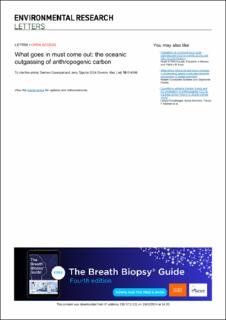| dc.contributor.author | Couespel, Damien | |
| dc.contributor.author | Tjiputra, Jerry | |
| dc.date.accessioned | 2024-02-19T14:26:14Z | |
| dc.date.available | 2024-02-19T14:26:14Z | |
| dc.date.created | 2024-01-30T13:26:32Z | |
| dc.date.issued | 2024 | |
| dc.identifier.citation | Environmental Research Letters. 2024, 19 (1), 1-14. | en_US |
| dc.identifier.issn | 1748-9326 | |
| dc.identifier.uri | https://hdl.handle.net/11250/3118514 | |
| dc.description.abstract | About 25% of the emitted anthropogenic CO2 is absorbed by the ocean and transported to the interior through key gateways, such as the Southern Ocean or the North Atlantic. Over the next few centuries, anthropogenic CO2 is then redistributed by ocean circulation and stored mostly in the upper layers of the subtropical gyres. Because of the combined effects of (i) weakening buffering capacity, (ii) warming-induced lower solubility, (iii) changes in wind stress and (iv) changes in ocean circulation, there is a high confidence that the ocean sink will weaken in the future. Here, we use IPCC-class Earth System Model (ESM) simulations following the SSP1-2.6 and SSP5-8.5 climate change scenarios extended to the year 2300 to reveal that anthropogenic CO2 begins to outgas in the subtropical gyres of both hemispheres during the summer months of the 21st century. In 2100, about 53% of the surface ocean experience outgassing at least one month in a year in SSP1-2.6, against 37% in SSP5-8.5. After 2100, this fraction keeps increasing, reaching 63% by 2300 in SSP5-8.5 while stabilizing at 55% in SSP1-2.6. This outgassing pattern is driven by the rapid increase in oceanic pCO2, faster than the atmospheric pCO2, due to the combined effect of both rapid warming and long-term accumulation of anthropogenic carbon in these regions. These findings call for increased observation efforts in these areas, particularly in the subtropical gyres of the Southern Hemisphere, in order to detect future release of anthropogenic carbon and accurately constrain the future carbon budget. | en_US |
| dc.language.iso | eng | en_US |
| dc.rights | Navngivelse 4.0 Internasjonal | * |
| dc.rights.uri | http://creativecommons.org/licenses/by/4.0/deed.no | * |
| dc.title | What goes in must come out: the oceanic outgassing of anthropogenic carbon | en_US |
| dc.title.alternative | What goes in must come out: the oceanic outgassing of anthropogenic carbon | en_US |
| dc.type | Peer reviewed | en_US |
| dc.type | Journal article | en_US |
| dc.rights.holder | © 2024 The Author(s) | en_US |
| dc.description.version | publishedVersion | en_US |
| cristin.ispublished | true | |
| cristin.fulltext | postprint | |
| cristin.qualitycode | 2 | |
| dc.identifier.doi | 10.1088/1748-9326/ad16e0 | |
| dc.identifier.cristin | 2238341 | |
| dc.source.journal | Environmental Research Letters | en_US |
| dc.source.volume | 19 | en_US |
| dc.source.issue | 1 | en_US |
| dc.source.pagenumber | 1-14 | en_US |

